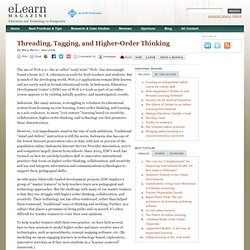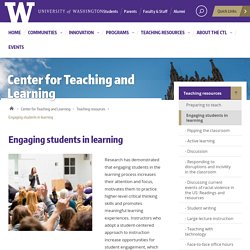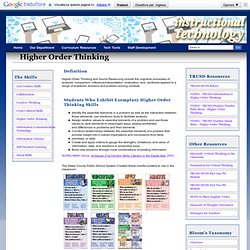

Web 2.0 teaching tools to enhance education and learning — Edjudo. Educational-origami - Bloom's Digital Taxonomy. Blooms Taxonomy Web 2.0 Livebinder. 84 (And Counting) Bloom's Taxonomy Tools Worth Trying. Bloom's Digital Taxonomy and Web 2 Tools by pip cleaves on Prezi. Integrating Technology, Higher-Order Thinking, and Student-Centered... Threading, Tagging, and Higher-Order Thinking. The use of Web 2.0—the so called "read/write" Web—has increasingly found a home in U.S. education as tools for both teachers and students.

But in much of the developing world, Web 2.0 applications remain little known and are rarely used as formal educational tools. In Indonesia, Education Development Center's (EDC) use of Web 2.0 tools as part of an online course appears to be yielding initially positive, and unanticipated, results. Indonesia, like many nations, is struggling to refashion its educational system from focusing on rote learning, lower-order thinking, and learning as a solo endeavor, to more "21st century" learning based on creativity, collaboration, higher-order thinking, and technology use that promotes these characteristics.
However, real impediments stand in the way of such ambitions. Traditional "stand and deliver" instruction is still the norm. Web 2.0 Tools Based on Bloom's Digital Taxonomy - Web 2.0 Tools Based on Bloom's Digital Taxonomy. Center for Teaching and Learning. Research has demonstrated that engaging students in the learning process increases their attention and focus, motivates them to practice higher-level critical thinking skills and promotes meaningful learning experiences.

Instructors who adopt a student-centered approach to instruction increase opportunities for student engagement, which then helps everyone more successfully achieve the course’s learning objectives. Flipping the classroom A pedagogy-first approach to teaching in which in-class time is re-purposed for inquiry, application and assessment in order to better meet the needs of the individual learners.
Read more Promoting student engagement through active learning Active learning requires students to participate in class, as opposed to sitting and listening quietly. Read more Leading dynamic discussions While “good” discussions can be a powerful tool for encouraging student learning, successful discussions rarely happen spontaneously. Read more Large lecture instruction. DIGITAL LEARNING ENVIRONMENTS: Tools and Technologies for Effective Classrooms.
Bloomsapps. Using Blooms Taxonomy in education is a highly effective way to scaffold learning for the students.

With the recent popularity and pervasive nature of iOS devices in school districts it is essential for educators to understand how to implement Blooms in the classroom using the apps that are available. While this list is by no means fully comprehensive, it will assist educators in getting started when implementing iOS devices in the classroom. This site will change almost daily as it will be updated with new and exciting apps! If you find any that you have worked with in your classroom please email dmileham@e1b.org or tweet @bloomsapps or @dmileham75 with your suggestions. Thanks for checking the site! Two Links to some iTunesU courses relating to iOS Integration: 1 iPad by Erie 1 Boards of Cooperative Educational Services ( Movie Making\Digital Storytelling Camera to PDF Free - cool little app that turns your device into a scanner.
LiveBinders: I would be remiss if I didn't post this. Blooms Taxonomy with Apps. Instructional Technology Department: Higher Order Thinking. Higher-Order Thinking and Sound Reasoning include the cognitive processes of analysis, comparison, inference/interpretation, evaluation, and synthesis applied to a range of academic domains and problem-solving contexts Identify the essential elements in a problem as well as the interaction between those elements; use electronic tools to facilitate analysisAssign relative values to essential elements of a problem and use those values to rank elements in meaningful ways; assess similarities and differences in problems and their elementsConstruct relationships between the essential elements of a problem that provide insight into it; extract implications and conclusions from facts,premises, or data.Create and apply criteria to gauge the strengths, limitations, and value of information, data, and solutions in productive waysBuild new solutions through novel combinations of existing information NCREL/Metiri Group. enGauge 21st Century Skills: Literacy in the Digital Age. 2003.

Instructional Technology Department: Higher Order Thinking. 5 Tech-Friendly Lessons to Encourage Higher-Order Thinking. Media Literacy | Viewpoint Page 2 of 2 5 Tech-Friendly Lessons to Encourage Higher-Order Thinking 4.

Thinking Out Loud A screencast is a recording of what’s happening on a computer or tablet screen and typically includes audio. Challenge students to create a video tutorial that demonstrates a skill or explains a basic concept using a screencasting app (e.g., Screen Chomp, ShowMe, or Educreations for iPad) or screencasting program for a laptop (e.g., Jing or Screencast-O-Matic). 5. Based on a Flickr group, Five Photo Stories tell tales using five images with no supporting text or audio, aside from the story title. Photo 1: Establish character(s) and setting Photo 2: Create a situation where multiple actions might occur Photo 3: Engage the character(s) in the situation Photo 4: Built toward a likely outcome Photo 5: End with a surprising--but logical--finish About the Author Susan Brooks-Young is an education consultant and author based in Lopez Island, WA and Vancouver, BC.